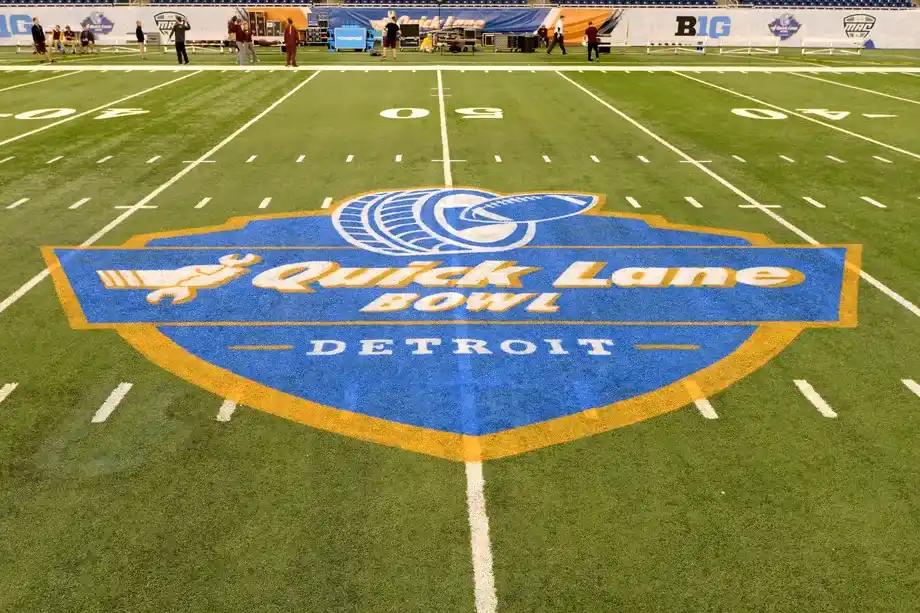•
Written By
Written By
•
•
•
Loading article...
Written By
Written By
Written By
Omar-Rashon Borja
Senior Writer, Editor, Historian
Written By
Omar-Rashon Borja
Senior Writer, Editor, Historian

2018 was the last time a Big Ten school appeared in Detroit’s Quick Lane Bowl when Minnesota defeated Georgia Tech 34-10. Since then, the Big Ten has not had enough bowl-eligible teams to fill the bowl largely due to the conference sending a plethora of teams to the New Year’s Six and the Quick Lane Bowl being at the bottom of the Big Ten’s bowl selection order.
As a result, the Quick Lane Bowl had to invite Nevada in 2021 and New Mexico State in 2022 to replace a Big Ten team, with both schools over 1600 miles from Detroit. Attendance has struggled, with the last two games drawing under 23,000, the lowest attendance for the bowl since the 2017 edition, which drew 20,117.
This is why the Big Ten’s additions of UCLA and USC bring good news for the Quick Lane Bowl as the Big Ten will have 16 teams for the final two years of the 2020-2025 bowl cycle. Barring the Big Ten sending four or five teams to the 12 team playoff, the Quick Lane Bowl should get a Big Ten team every year.
Ideally, this could mean the Quick Bowl hosts one of the Big Ten’s smaller football brands like Indiana or Illinois instead of an at-large team. This is great for in-person attendance for the bowl for obvious reasons and even local interest as several Big Ten schools likely have solid alumni bases in the Detroit area as well as it being an easy trip for local fans.
On the other hand, Big Ten expansion could hurt the Quick Lane Bowl further. The Big Ten has a lack of West Coast bowls which causes nightmares for USC and the conference’s bowl partners. USC and UCLA’s brand alone may not be enough for the Big Ten’s bowl partners to take a chance and invite the California schools. This may cause every bowl to pass on USC or UCLA until it is the Quick Lane Bowl’s turn to choose, which is bad for both parties for several reasons. Just look at the distance of USC and UCLA from each Big Ten bowl partner below:

Aside from the obvious problem of distance, it may be hard for USC and UCLA fans to get excited to play in the Quick Lane Bowl against a MAC school. The last time USC went to a non-New Year’s Six/BCS bowl east of El Paso was the 1987 Citrus Bowl, while the last time UCLA went to a non-New Year’s Six/BCS bowl east of San Antonio was the 1981 Bluebonnet Bowl. To say this is an unprecedented trip would be an understatement. Not to mention, getting Californians to spend their Christmas in the cold of Detroit is a tough sell.
However, some good may come out of the Quick Lane Bowl getting USC and UCLA as the bowl the two programs would likely attract a more national audience for the bowl game. While drawing respectable ratings in 2022 despite featuring an all-Group of Five matchup, the 2021 game had horrid viewership, ranking as the fourth-least watched bowl with a 0.7 rating and 1.066 million viewers. USC and UCLA playing in the game virtually by default would boost TV ratings through drawing the Los Angeles TV market and providing a national brand.
The MAC also wins as the Big Ten's inability to fulfill their agreement with the Quick Lane Bowl has deprived the MAC of a standalone game against a Power Five team that pre-empts Monday Night Football's pregame. This is a huge opportunity the league regains with more teams for the Big Ten's bowl partners to choose from.
This new era of college football brings new possibilities for one of college football’s few cold weather bowl games. The vast expanse of the Big Ten could hurt the Quick Lane Bowl or revitalize it. Only time will tell how it affects everyone’s favorite bowl sponsored by a car products company.